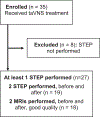Transcutaneous auricular vagus nerve stimulation (taVNS) given for poor feeding in at-risk infants also improves their motor abilities
- PMID: 36093716
- PMCID: PMC9976577
- DOI: 10.3233/PRM-210090
Transcutaneous auricular vagus nerve stimulation (taVNS) given for poor feeding in at-risk infants also improves their motor abilities
Abstract
Purpose: Transcutaneous auricular vagus nerve stimulation (taVNS) is a non-invasive neuromodulation technique that may improve oromotor skills when paired with feeding in at-risk infants, but effects on other motor function and how motor function relates to white matter (WM) microstructure are unknown.
Methods: In this prospective study, infants failing oral feeds and slated for gastrostomy tube (G-tube) placement received taVNS paired with bottle feeding daily for 2-3 weeks. The effects of taVNS-paired feeding on general and specific head movements were investigated using the Specific Test of Early infant motor Performance (STEP) and diffusion MRI obtained before and after taVNS treatment. Scores between and within groups (taVNS responders, attained full oral feeds; non-responders, received G-tubes) were compared.
Results: Performance on head movement items improved significantly in responders but not in non-responders (p < 0.05). Total STEP scores were significantly higher in responders after taVNS treatment than non-responders (p = 0.04). One STEP item, rolling by arm, was associated with significantly greater change in WM tract microstructure (p < 0.05) in the responders.
Conclusion: These results suggest that pairing feeding with taVNS may affect specific head and neck movements to a greater extent in infants who are able to attain full oral feeds.
Keywords: Diffusion MRI; Early motor movement; Oral-feed; STEP; infant development; taVNS.
Conflict of interest statement
Conflict of interest
The authors have no conflicts of interest to report.
Figures




Similar articles
-
Higher Dose Noninvasive Transcutaneous Auricular Vagus Nerve Stimulation Increases Feeding Volumes and White Matter Microstructural Complexity in Open-Label Study of Infants Slated for Gastrostomy Tube.J Pediatr. 2023 Nov;262:113563. doi: 10.1016/j.jpeds.2023.113563. Epub 2023 Jun 16. J Pediatr. 2023. PMID: 37329979 Free PMC article.
-
Transcutaneous Auricular Vagus Nerve Stimulation-Paired Rehabilitation for Oromotor Feeding Problems in Newborns: An Open-Label Pilot Study.Front Hum Neurosci. 2020 Mar 18;14:77. doi: 10.3389/fnhum.2020.00077. eCollection 2020. Front Hum Neurosci. 2020. PMID: 32256328 Free PMC article.
-
Motor Activated Auricular Vagus Nerve Stimulation as a Potential Neuromodulation Approach for Post-Stroke Motor Rehabilitation: A Pilot Study.Neurorehabil Neural Repair. 2023 Jun;37(6):374-383. doi: 10.1177/15459683231173357. Epub 2023 May 20. Neurorehabil Neural Repair. 2023. PMID: 37209010 Free PMC article. Clinical Trial.
-
Transcutaneous auricular vagus nerve stimulators: a review of past, present, and future devices.Expert Rev Med Devices. 2022 Jan;19(1):43-61. doi: 10.1080/17434440.2022.2020095. Epub 2022 Jan 13. Expert Rev Med Devices. 2022. PMID: 34937487 Review.
-
Transcutaneous Auricular Vagus Nerve Stimulation Combined With Slow Breathing: Speculations on Potential Applications and Technical Considerations.Neuromodulation. 2022 Apr;25(3):380-394. doi: 10.1111/ner.13458. Epub 2021 Jun 23. Neuromodulation. 2022. PMID: 35396070 Review.
Cited by
-
Use of non-invasive transcutaneous auricular vagus nerve stimulation: neurodevelopmental and sensory follow-up.Front Hum Neurosci. 2023 Nov 9;17:1297325. doi: 10.3389/fnhum.2023.1297325. eCollection 2023. Front Hum Neurosci. 2023. PMID: 38021221 Free PMC article.
-
Pairing taVNS and CIMT is feasible and may improve upper extremity function in infants.Front Pediatr. 2024 Feb 13;12:1365767. doi: 10.3389/fped.2024.1365767. eCollection 2024. Front Pediatr. 2024. PMID: 38415207 Free PMC article.
References
Publication types
MeSH terms
Grants and funding
LinkOut - more resources
Full Text Sources
Medical

